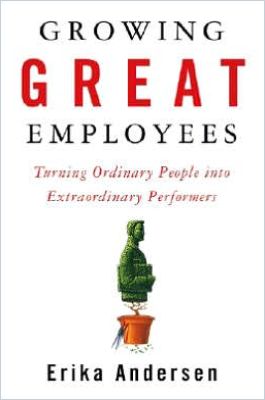Consultant and author Erika Andersen explores a gardening metaphor to help you hire, nurture and retain the best employees.

Nurture Employee Growth
This useful guide offers strategies that can help you nurture your staff’s productivity as you develop as a manager. Erika Andersen, founder of the consulting firm Proteus International, provides case studies and hands-on tools that enable you to apply what you learn as you read.
As a gardener prepares the soil…to allow the plants an ideal growing environment, listening well creates the ideal human growth environment.Erika Andersen
Her excellent manual explains how to become a master at hiring and retaining strong employees, a crucial facet of building your business. Andersen also provides insightful advice on how to decide that someone isn’t going to fit in and how to let that person go gracefully and with compassion.
Planting the Seeds
Cultivating employees who will do well at your company is like planting a garden. You must prepare the soil, put people – like seeds – in the right place and nurture their growth.
Every day, companies enlist people who turn out to be inappropriate for their positions. Or companies hire people without giving them the tools and coaching to succeed. Andersen emphasizes that this is a lot like planting a garden and failing to care for it.
Growing a garden and growing employees both require time, thought, skill and knowledge.Erika Andersen
Cultivating great employees starts with learning to recruit, interview and hire solid candidates and then working hard after you hire them to make sure they thrive in your company. To avoid turnover, focus on employee growth the way master gardeners focus on their flowers.
Breaking Ground
Being a good manager demands attentive listening, which itself requires managing your thoughts and actions. Andersen advises giving your full attention when someone is talking to you, encouraging the speaker to keep talking, asking questions and summarizing what you heard to elicit the speaker’s feedback.
In managing people, the right effort yields employees who thrive and are productive [which] means motivated, self-sufficient, capable and good with others.Erika Andersen
Gardeners decide what kind of garden they want to create and then choose the plants they need. Before you start interviewing, decide what skills you need a new person to have and consider only candidates with those qualifications. Developing your job description with care leads to a more concise, rewarding interview process for you and your candidates.
Resumés are marketing documents and door openers, Andersen explains, but you need to know how candidates will perform on the job. She advises staging simulations or setting up scenarios and asking candidates how they might react to certain situations. Get feedback from candidates’ potential co-workers on how they performed in these scenarios. Which candidates do they see as potential assets?
Maintaining Your Garden
Gardeners plant different plants at the right depths so their roots get the nourishment they need. Just as you can plant a bush at the wrong depth, you may give new employees too much information or not enough, and either situation can make them wilt. Instead, says Andersen, identify the people new employees will deal with daily, make sure they know how things work in your organization and delineate their responsibilities.
When they are genuinely listened to, employees tend to put down roots and to thrive – to be loyal and committed, and to be more enthusiastic about achieving great results.Erika Andersen
Like plants that need varying amounts of fertilizer, sunshine and rain, different employees need different managerial approaches. Listen carefully to discover what motivates each new hire. To adapt your fertilizing tactics accordingly, study how they relate to others and try to figure out what they need, such as clear directions or a high level of freedom. Other new hires may thrive given consistent, two-way communication with you. Some team-focused employees need to feel that they fit in. Others want maximum information and workable timeframes for each task. No one has only one style, so observe each new person carefully so you can discern which methods fit each employee.
To gain employees’ agreement and commitment, Andersen says, be clear about your expectations. Once they commit to your mutual goals, help them monitor their progress by giving them feedback.
Master Gardener
Andersen urges you to delegate responsibility to help your employees take ownership of their work and to free yourself to focus on more strategic tasks. Think through the scope of the responsibilities you are assigning, your employees’ ability to take ownership of that responsibility and the assistance they will need to succeed. Discuss their targeted duties and provide a written summary as their manual.
What we call ‘good teaching’ is mostly about teaching in a way that aligns with the way people learn.Erika Andersen
Delegation does not mean dumping your responsibilities onto someone else. Use delegation to help employees realize their potential.
Raising Future Coaches
Andersen’s ultimate growth strategy is to describe, demonstrate and teach coaching to your employees so they become coaches themselves. When you help someone gain the skills to lead teams in the future, you create an employee who will bring value to the company for years to come.
The only real measure of the effectiveness of my teaching is what happens in the mind of the person learning.Erika Andersen
Develop the mind-set of a teacher or coach to groom your employees to succeed in a role similar to yours. Balance is important – your coaching is necessary, but employees may offset it by taking responsibility for their growth. Responsible employees listen, keep their promises and remain considerate of others.
Pulling Weeds
Weed people out when they can no longer grow or flourish.
Be clear and concise about your expectations and about an employee’s failure to meet them. Termination should come as no surprise if you always provide an employee with feedback on how to improve and then gauge whether he or she follows that path. Then, if you do have to fire the employee, you will know you offered him or her every opportunity to succeed.
No matter how good the plants are, no matter how much you water or fertilize later on – unless you start by creating a rich, open environment for your plants to grow in, you are doomed to failure.Erika Andersen
Cultivate positive change in your organization. Even if you are responsible for only a few areas, manage those tasks like a master gardener to create a flourishing coaching environment. Find a senior coach – someone you admire who will nurture your growth by sharing his or her knowledge. Prioritize your personal growth to nurture great employees.
Direct Directions
Andersen is a blunt, no-nonsense, direct writer. She lays her advice out clearly and wastes little space convincing you to follow it. That makes this guide easy to read and her guidance easy to retain. While much of Andersen’s advice may not not be new to experienced managers, she may still provide a welcome overview or reminder. Even if you love gardening, Andersen’s gardening analogy wears a bit thin, but its metaphors prove valid. And, her gardening framework enables the author to lay out a solid road map for hiring and developing employees. Given her theme of nurturing, her manual may best suit new managers who require some nurturing themselves.
Erika Andersen also wrote Being Strategic: Plan for Success, Out-Think Your Competitors; Stay Ahead of Change and Leading So People Will Follow.










